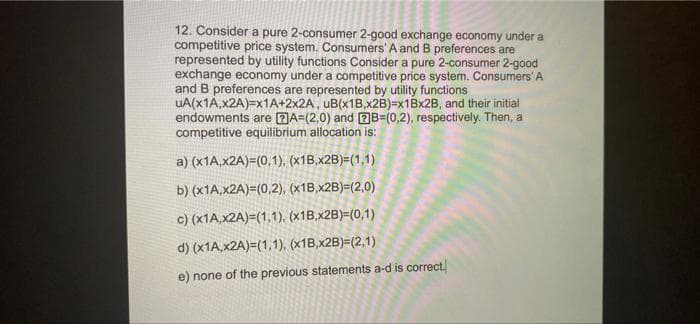12. Consider a pure 2-consumer 2-good exchange economy under a competitive price system. Consumers' A and B preferences are represented by utility functions Consider a pure 2-consumer 2-good exchange economy under a competitive price system. Consumers' A and B preferences are represented by utility functions uA(x1A,x2A)=x1A+2x2A, uB(x1B,x2B)=x1Bx2B, and their initial endowments are FA=(2,0) and (78=(0,2), respectively. Then, a competitive equilibrium allocation is: a) (x1A,x2A)=(0,1), (x1B.x2B)=(1,1) b) (x1A,x2A)=(0,2), (x1B,x2B)=(2,0) c) (x1A,x2A)=(1,1). (x1B,x2B)=(0,1) d) (x1A,x2A)=(1,1), (x1B,x2B)=(2,1) e) none of the previous statements a-d is correct.
12. Consider a pure 2-consumer 2-good exchange economy under a competitive price system. Consumers' A and B preferences are represented by utility functions Consider a pure 2-consumer 2-good exchange economy under a competitive price system. Consumers' A and B preferences are represented by utility functions uA(x1A,x2A)=x1A+2x2A, uB(x1B,x2B)=x1Bx2B, and their initial endowments are FA=(2,0) and (78=(0,2), respectively. Then, a competitive equilibrium allocation is: a) (x1A,x2A)=(0,1), (x1B.x2B)=(1,1) b) (x1A,x2A)=(0,2), (x1B,x2B)=(2,0) c) (x1A,x2A)=(1,1). (x1B,x2B)=(0,1) d) (x1A,x2A)=(1,1), (x1B,x2B)=(2,1) e) none of the previous statements a-d is correct.
Chapter6: Demand Relationships Among Goods
Section: Chapter Questions
Problem 6.5P
Related questions
Question
2

Transcribed Image Text:12. Consider a pure 2-consumer 2-good exchange economy under a
competitive price system. Consumers' A and B preferences are
represented by utility functions Consider a pure 2-consumer 2-good
exchange economy under a competitive price system. Consumers' A
and B preferences are represented by utility functions
UA(x1A,x2A)=x1A+2x2A, uB(x1B,x2B)=x1Bx2B, and their initial
endowments are DA=(2,0) and 2B=(0,2), respectively. Then, a
competitive equilibrium allocation is:
a) (x1A,x2A)=(0,1), (x1B,x2B)=(1,1)
b) (x1A.x2A)=(0,2), (x1B,x2B)=(2,0)
c) (x1A,x2A)=(1,1), (x1B,x2B)=(0,1)
d) (x1A,x2A)=(1,1), (x1B,x2B)=(2,1)
e) none of the previous statements a-d is correct.
Expert Solution
This question has been solved!
Explore an expertly crafted, step-by-step solution for a thorough understanding of key concepts.
Step by step
Solved in 2 steps

Knowledge Booster
Learn more about
Need a deep-dive on the concept behind this application? Look no further. Learn more about this topic, economics and related others by exploring similar questions and additional content below.Recommended textbooks for you

